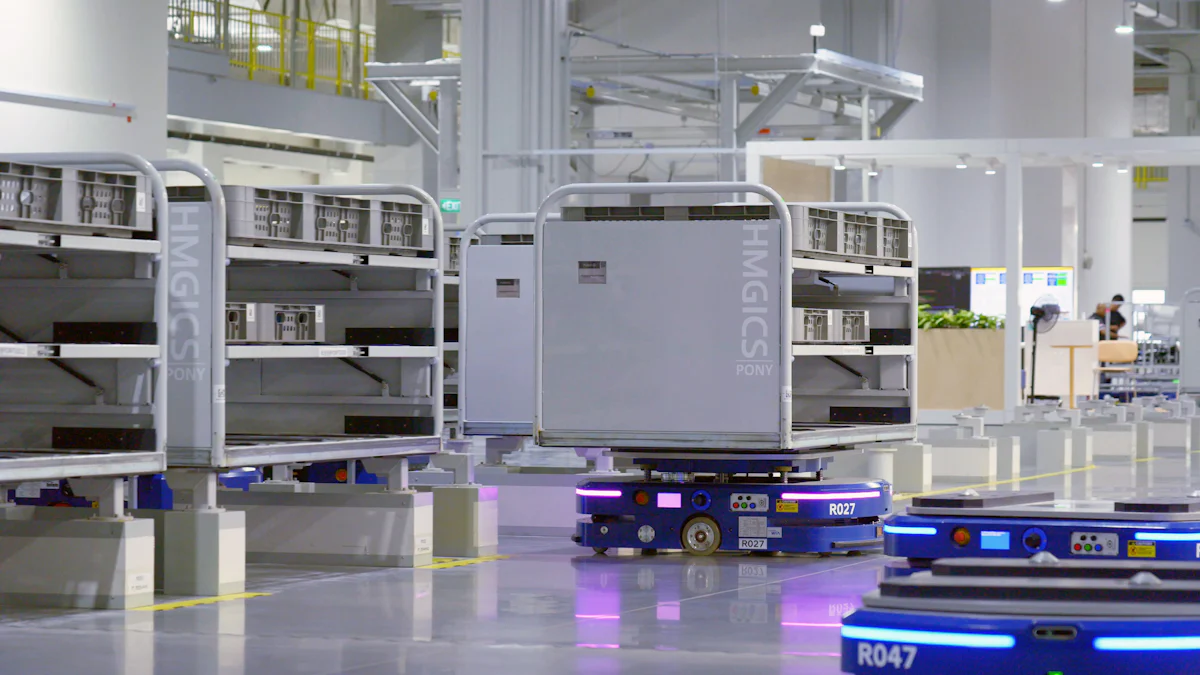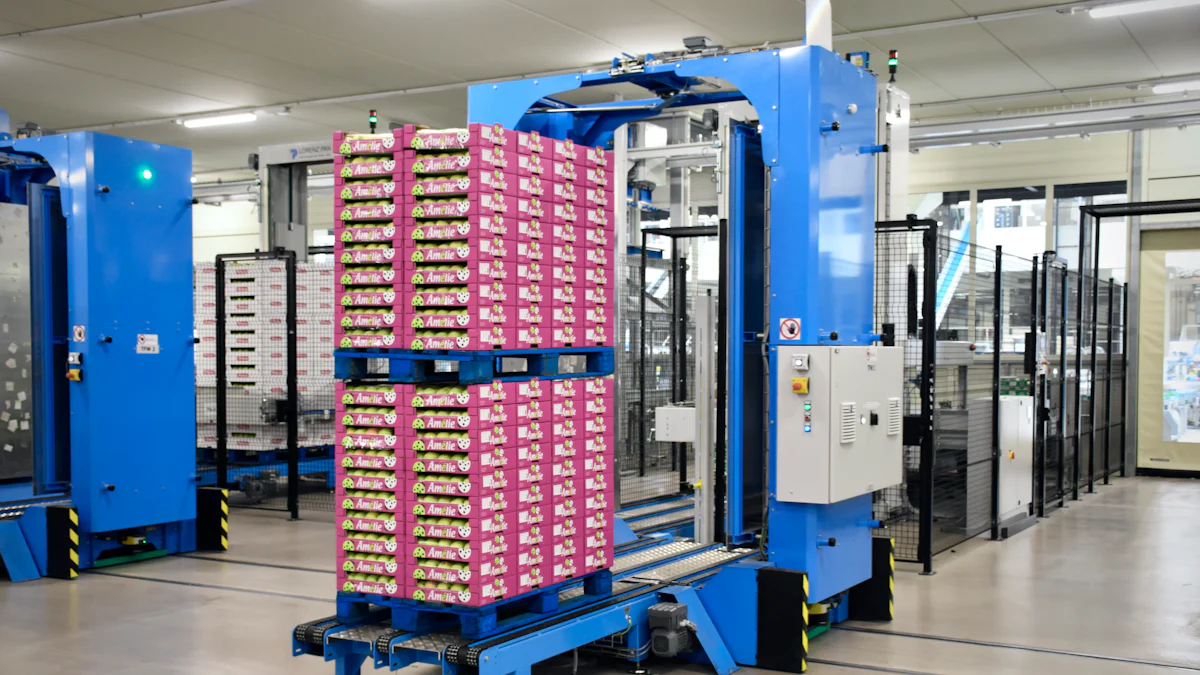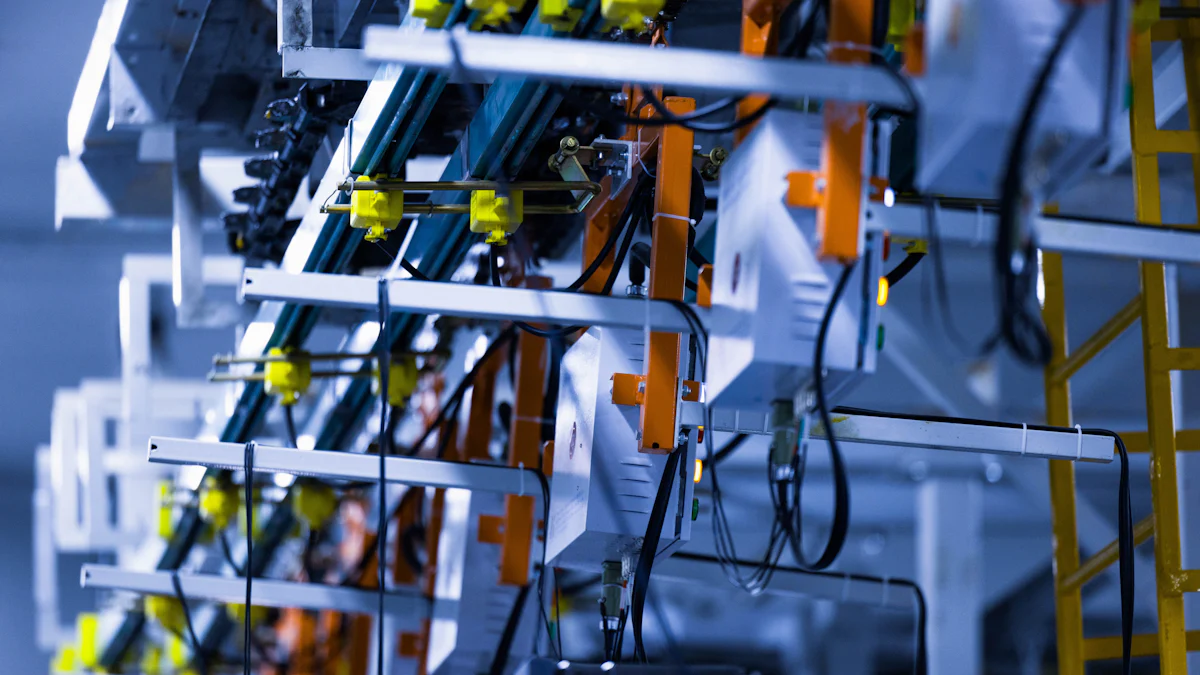Trends in Automated Warehousing for Enhanced Efficiency

Automated warehousing transforms traditional storage facilities into efficient hubs. Automation enhances productivity by 25% and optimizes space usage by 20%. Businesses benefit from reduced labor costs, which can decrease by up to 60%, while accuracy improves with robotics and automated guided vehicles (AGVs). Automated systems streamline operations, providing real-time inventory visibility and minimizing errors. These advancements lead to faster fulfillment times and improved safety, as machines handle hazardous tasks. The integration of automation in warehouses results in a more streamlined and effective operation.
Current State of Automated Warehousing

Definition and Scope
Key components of automated warehousing
Automated warehousing involves several key components that enhance operational efficiency. Robotics play a significant role by handling repetitive tasks with precision. Automated guided vehicles (AGVs) transport goods within the warehouse. Conveyor systems streamline the movement of items. Warehouse management software (WMS) integrates these technologies, providing centralized control. The Internet of Things (IoT) connects devices, enabling real-time data exchange. Sensors monitor inventory levels and environmental conditions. These components work together to create a seamless and efficient warehousing environment.
Current adoption rates and industry statistics
The adoption of automated warehousing varies across industries. Only 15% of warehouses have mechanized operations in recent years. Sophisticated automation equipment is present in just 5% of facilities. Despite this, industry predictions indicate a shift. By 2030, the adoption rate is expected to rise to 45%. This growth reflects a significant increase from the 8% rate in 2019. Many companies plan to invest in conveyor and sortation systems. An estimated 60% of businesses aim to implement these technologies. Automation remains a critical driver of efficiency in logistics.
Technologies in Use
Robotics and automation systems
Robotics and automation systems revolutionize warehouse operations. Robots perform tasks such as picking, packing, and sorting. These machines operate with high accuracy and speed. Automated systems reduce human error and labor costs. AGVs navigate warehouse floors autonomously. These vehicles transport goods efficiently. Robotics enhance productivity and safety in warehouses.
Warehouse management software
Warehouse management software (WMS) optimizes warehouse processes. This software provides real-time inventory tracking. WMS ensures accurate order fulfillment and stock management. The system integrates with other technologies, creating a cohesive operation. Data analytics within WMS supports decision-making. Businesses benefit from streamlined operations and improved efficiency.
Internet of Things (IoT) and sensors
The Internet of Things (IoT) connects devices within warehouses. IoT enables seamless communication between equipment. Sensors play a vital role in monitoring conditions. These devices track temperature, humidity, and inventory levels. Real-time data collection enhances visibility and control. IoT and sensors contribute to proactive maintenance and efficient resource utilization.
Benefits of Automated Warehousing
Operational Efficiency
Reduction in Labor Costs
Automation in warehousing significantly reduces labor costs. Robotics and automated systems perform repetitive tasks. These technologies replace manual labor, leading to cost savings. Businesses experience a decrease in human error. The reduction in labor costs enhances overall profitability.
Increased Accuracy and Speed
Automated systems improve accuracy and speed in warehouse operations. Robotics handle tasks with precision. Automated guided vehicles (AGVs) transport goods efficiently. These technologies ensure high-speed operations. The increase in accuracy reduces order errors. Faster processing times lead to quicker order fulfillment.
Inventory Management
Real-time Tracking and Monitoring
Real-time tracking and monitoring transform inventory management. Sensors and IoT devices provide continuous data. Warehouse management software (WMS) integrates this information. Businesses gain visibility into inventory levels. Real-time data enables proactive decision-making.
Improved Stock Control and Forecasting
Automation enhances stock control and forecasting capabilities. Data analytics within WMS supports inventory management. Businesses optimize stock levels based on demand patterns. Improved forecasting reduces overstock and stockouts. Efficient stock control leads to better resource utilization.
JUSDA's Role in Automated Warehousing
JUSDA's Cloud Warehouse Solutions
JUSDA offers innovative cloud warehouse solutions that transform warehousing operations. The integration of advanced technology allows seamless management of multi-channel sales. Businesses can efficiently handle orders from various platforms, ensuring timely delivery and customer satisfaction. JUSDA's cloud solutions provide a unified system that connects all sales channels, enhancing operational efficiency.
Advanced warehouse planning and process design form the backbone of JUSDA's cloud warehouse solutions. Strategic planning optimizes space utilization and streamlines workflows. The implementation of automated systems reduces manual intervention, increasing productivity and accuracy. JUSDA employs dynamic slotting optimization to maximize storage space. Automated loading procedures further enhance operational efficiency by minimizing manual labor.
JusLink Platform
The JusLink Platform provides full-chain supply chain visibility, a critical component in modern warehousing. Real-time monitoring systems track inventory levels and environmental conditions. This capability allows businesses to make informed decisions and respond quickly to changes in demand. The platform's comprehensive visibility ensures that all supply chain nodes are synchronized, reducing delays and improving service levels.
Data-driven decision-making is at the heart of the JusLink Platform. The platform leverages extensive data analytics to support strategic planning and operational improvements. Businesses benefit from insights that drive efficiency and optimize resource allocation. The integration of AI-driven solutions and smart drones enhances the platform's capabilities, providing a robust framework for automated warehousing.
JUSDA's commitment to innovation and excellence ensures that its warehousing solutions remain at the forefront of industry advancements. The combination of cloud warehouse solutions and the JusLink Platform empowers businesses to achieve greater efficiency and effectiveness in their operations.

JUSDA Solutions
To provide you with professional solutions and quotations.
Challenges in Implementing Automation
Financial Considerations
Initial Investment Costs
Automated warehousing requires significant financial costs. Businesses must acquire advanced technology and equipment. Installation expenses add to the financial burden. Companies often face substantial initial investment costs. These costs can deter smaller businesses from adopting automation.
Return on Investment Analysis
Businesses need to analyze the return on investment (ROI) for automation. ROI analysis helps determine the financial benefits of automation. Companies evaluate cost savings from reduced labor expenses. Increased efficiency and accuracy contribute to ROI. A thorough analysis ensures informed decision-making.
Technical Challenges
Integration with Existing Systems
Integrating automation with existing systems presents challenges. Businesses must ensure compatibility between new and old technologies. Successful integration requires careful planning and execution. Companies often face difficulties during the integration process. Technical expertise is crucial for seamless system integration.
Maintenance and Technical Support
Automated systems require regular maintenance. Businesses must provide technical support for automated equipment. Maintenance ensures optimal performance and longevity. Companies often need skilled technicians for maintenance tasks. Reliable technical support minimizes downtime and operational disruptions.
Future Trends in Automated Warehousing

Emerging Technologies
Artificial Intelligence and Machine Learning
Artificial intelligence (AI) and machine learning are revolutionizing automated warehousing. AI algorithms analyze vast amounts of data to optimize warehouse operations. Machine learning models predict demand patterns, enhancing inventory management. These technologies improve decision-making by providing actionable insights. AI-driven systems automate complex tasks, increasing operational efficiency. Businesses experience reduced errors and enhanced accuracy through AI integration.
Autonomous Vehicles and Drones
Autonomous vehicles and drones represent the future of automated warehousing. These technologies automate the transportation of goods within warehouses. Autonomous vehicles navigate warehouse floors with precision. Drones offer aerial solutions for inventory monitoring and management. The use of autonomous vehicles reduces reliance on manual labor. Drones enhance inventory accuracy by providing real-time data. These advancements contribute to faster and more efficient warehouse operations.
Industry Predictions
Growth Projections and Market Trends
The automated warehousing industry is poised for significant growth. Analysts project a substantial increase in automation adoption rates. Businesses recognize the benefits of automation in improving efficiency. Market trends indicate a shift towards more sophisticated technologies. Companies invest in AI, robotics, and IoT to stay competitive. The demand for automated solutions continues to rise across industries.
Potential Impact on the Workforce
Automation in warehousing impacts the workforce in various ways. Automated systems reduce the need for manual labor in repetitive tasks. Workers transition to roles that require technical expertise and oversight. Training programs equip employees with skills for managing automated systems. Automation creates opportunities for new job roles in technology and maintenance. The workforce evolves to adapt to the changing landscape of warehousing.
Automated warehousing plays a crucial role in enhancing operational efficiency and accuracy. Businesses can achieve significant cost savings by reducing labor dependency and minimizing errors. Automation also enhances safety by handling hazardous tasks. The future of automated warehousing promises further advancements with emerging technologies like AI and autonomous vehicles. These innovations will continue to drive efficiency and performance. Businesses should consider adopting automation to remain competitive and agile in the evolving market landscape. Embracing automation ensures adaptability to changing customer demands and operational challenges.
See Also
Enhancing Productivity: Robotics Revolutionizing Warehouse Operations
Automated Tomorrow: Benefits of High-Tech Manufacturing Warehouses
Logistics Robotics Impact: Boosting Warehouse Efficiency
The Necessity of Warehouse Automation for Business Success
Maximizing Efficiency: Innovations in AI Supply Chain Management
